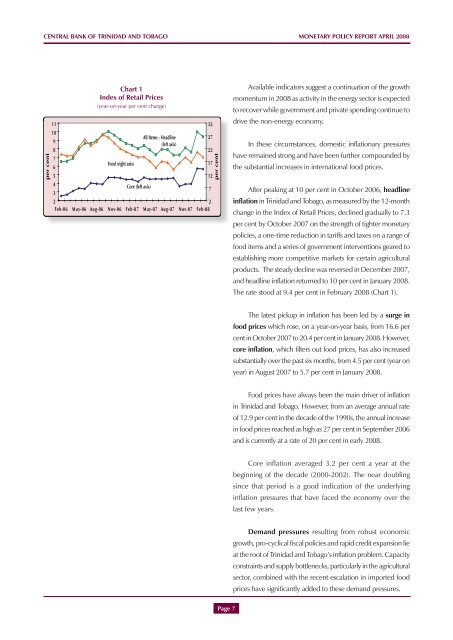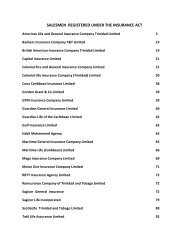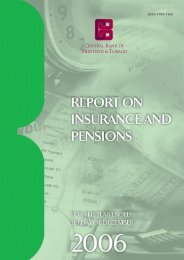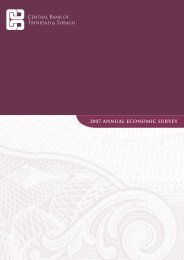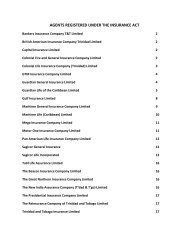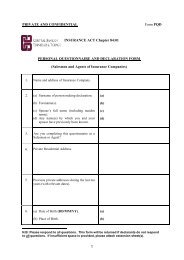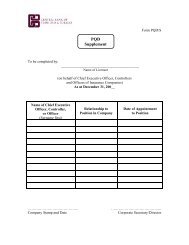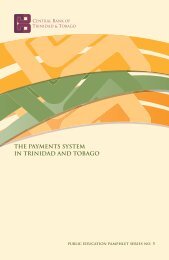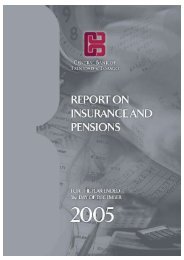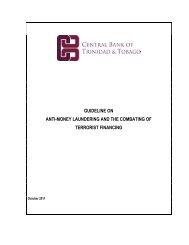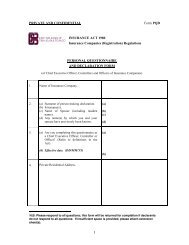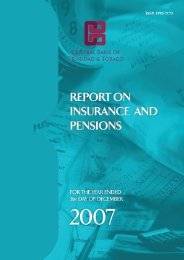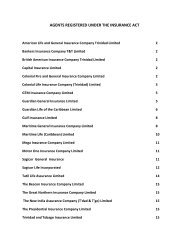April 2008 Report - Central Bank of Trinidad and Tobago
April 2008 Report - Central Bank of Trinidad and Tobago
April 2008 Report - Central Bank of Trinidad and Tobago
Create successful ePaper yourself
Turn your PDF publications into a flip-book with our unique Google optimized e-Paper software.
CENTRAL BANK OF TRINIDAD AND TOBAGO MONETARY POLICY REPORT APRIL <strong>2008</strong><br />
Chart 1<br />
Index <strong>of</strong> Retail Prices<br />
(year-on-year per cent change)<br />
Available indicators suggest a continuation <strong>of</strong> the growth<br />
momentum in <strong>2008</strong> as activity in the energy sector is expected<br />
to recover while government <strong>and</strong> private spending continue to<br />
drive the non-energy economy.<br />
In these circumstances, domestic inflationary pressures<br />
have remained strong <strong>and</strong> have been further compounded by<br />
the substantial increases in international food prices.<br />
After peaking at 10 per cent in October 2006, headline<br />
inflation in <strong>Trinidad</strong> <strong>and</strong> <strong>Tobago</strong>, as measured by the 12-month<br />
change in the Index <strong>of</strong> Retail Prices, declined gradually to 7.3<br />
per cent by October 2007 on the strength <strong>of</strong> tighter monetary<br />
policies, a one-time reduction in tariffs <strong>and</strong> taxes on a range <strong>of</strong><br />
food items <strong>and</strong> a series <strong>of</strong> government interventions geared to<br />
establishing more competitive markets for certain agricultural<br />
products. The steady decline was reversed in December 2007,<br />
<strong>and</strong> headline inflation returned to 10 per cent in January <strong>2008</strong>.<br />
The rate stood at 9.4 per cent in February <strong>2008</strong> (Chart 1).<br />
The latest pickup in inflation has been led by a surge in<br />
food prices which rose, on a year-on-year basis, from 16.6 per<br />
cent in October 2007 to 20.4 per cent in January <strong>2008</strong>. However,<br />
core inflation, which filters out food prices, has also increased<br />
substantially over the past six months, from 4.5 per cent (year on<br />
year) in August 2007 to 5.7 per cent in January <strong>2008</strong>.<br />
Food prices have always been the main driver <strong>of</strong> inflation<br />
in <strong>Trinidad</strong> <strong>and</strong> <strong>Tobago</strong>. However, from an average annual rate<br />
<strong>of</strong> 12.9 per cent in the decade <strong>of</strong> the 1990s, the annual increase<br />
in food prices reached as high as 27 per cent in September 2006<br />
<strong>and</strong> is currently at a rate <strong>of</strong> 20 per cent in early <strong>2008</strong>.<br />
Core inflation averaged 3.2 per cent a year at the<br />
beginning <strong>of</strong> the decade (2000-2002). The near doubling<br />
since that period is a good indication <strong>of</strong> the underlying<br />
inflation pressures that have faced the economy over the<br />
last few years.<br />
Dem<strong>and</strong> pressures resulting from robust economic<br />
growth, pro-cyclical fiscal policies <strong>and</strong> rapid credit expansion lie<br />
at the root <strong>of</strong> <strong>Trinidad</strong> <strong>and</strong> <strong>Tobago</strong>’s inflation problem. Capacity<br />
constraints <strong>and</strong> supply bottlenecks, particularly in the agricultural<br />
sector, combined with the recent escalation in imported food<br />
prices have significantly added to these dem<strong>and</strong> pressures.<br />
Page 7


